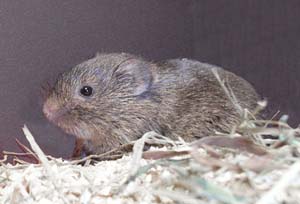
Prairie Vole
(Microtus ochrogaster)
Interesting facts:
Prairie voles use postures to indicate behaviors toward enemies or competitors. They signal a threat by raising their forefeet, extending their head forward, and chattering their teeth. Other postures are the upright stand, the lunge, boxing, wrestling, the chase, and retreat.
Description:
Prairie voles in Illinois have yellowish or reddish-tan underparts and dark brown head and back tipped with silver or tan. They measure 5 to 7 inches long.
Habitat and Behavior:
Prairie voles live in all parts of Illinios in grassy fields that are not too damp. They prefer pastures, alfalfa fields, prairies, and weedy areas. Near towns they live on golf courses and vacant lots. They part the grass at the ground level to make 2-inch wide runways between the entrances to their burrows, or from the burrows to their food source. They also use grass to line their underground nests.
Food:
Prairie voles eat roots and other parts of clovers, dandelions, alfalfa, penstemon, ambrosia, and goldenrod. They also eat bluegrass and other prairie grasses, and mosses.
Distribution and status:
The population of prairie voles varies from year to year, but they breed throughout Illinois.